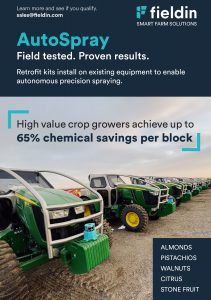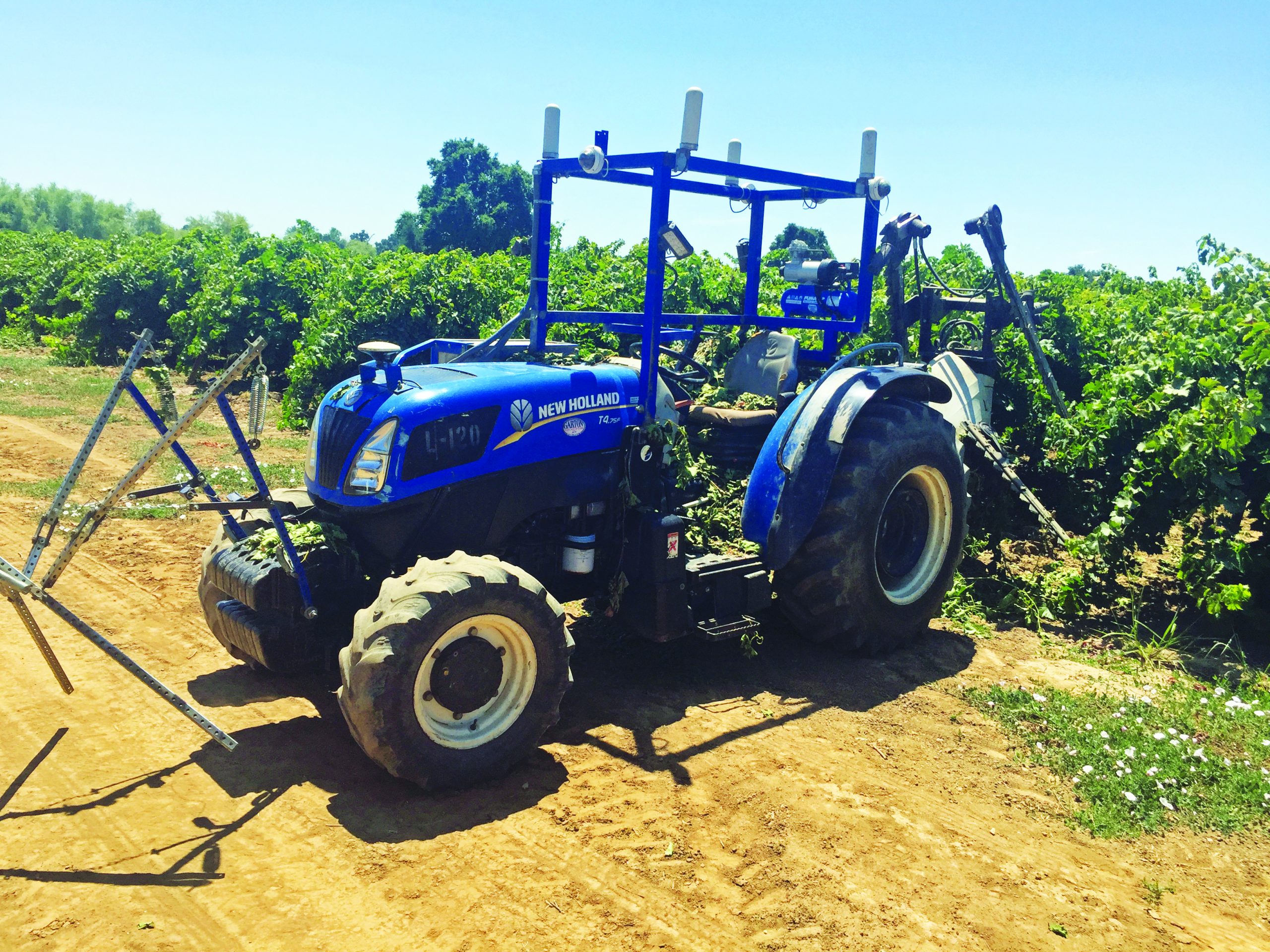By Vicky Boyd
Lodi-area vineyard manager Joe Valente has gone from skeptic to believer since he began working with Kingman Ag on a kit that converts conventional tractors into autonomous machines.
From one self-driving tractor that logged 1,200-1,400 hours mostly with a three-point disk near Thornton in 2022, Valente added two more units this season in Sacramento County.
“As far as the damage to the vines, it’s been very, very minimal and probably a whole lot less than with our normal tractor drivers,” he said. “We’re learning as we move along, but I’ve been impressed with it.”
Calling it still somewhat experimental, Valente said the technology has continued to evolve and be updated since he started working with Lemoore-based Kingman Ag more than three years ago.
This year, he’s also using the autonomous tractor in Thornton to trim vines. Traditionally, trimmers are mounted on the front of a tractor. But they interfered with some of the autonomous sensors, so they moved the trimmers to the rear.
“It’s kind of new, but it worked,” Valente said.
He isn’t alone in adopting labor-saving autonomous equipment, said Kingman Ag founder Connor Kingman, who partnered with Lemoore family farmer Ted Sheely and his sons to commercialize the technology.
“Our biggest challenge is ensuring we have the manufacturing and personnel to meet the demand,” Kingman said.
A handful of other companies, including Fieldin, have also begun offering autonomous retrofits as a way to bring the technology to market without the large capital outlay of stand-alone self-driving machines.
Using existing tractors
Kingman Ag’s conversion kit includes a tractor-mounted frame that is connected to the machine’s operating systems, including electrical, steering, hydraulic, PTO drive and power train.
Numerous cameras attached to the frame send images to an onboard computer, which helps steer the unit and detect obstacles.
Also fitted on the frame are LiDAR — light, detection and ranging — sensors that detect obstacles and relay the data to the computer. This is in addition to previously uploaded digital maps of each vineyard in which the tractor will operate.
Artificial intelligence, a type of high-powered computer programming that makes decisions and learns from repeated actions, draws from the data to help guide the tractor.
The conversion kit is compatible with John Deere, New Holland, Deutz Fahr and Kubota tractors used in vineyards, Kingman said.
Valente had been running the autonomous kit on a New Holland tractor in Thornton. When they mounted new systems on two Kubotas in Sacramento County this season, they found the tractors were 1.5 feet wider and the rows were 1 foot narrower.
That meant a tight squeeze for the cameras mounted on the sides, so Kingman moved them to the top of the frame. It worked better and will be a permanent design change moving forward.
As part of Kingman Ag’s service, all autonomous activities are monitored remotely by an employee, who can immediately shut off the tractor or notify the owner for less-pressing issues, such as low diesel levels. This helps them comply with California Occupational Safety and Health Administration rules on autonomous equipment operation.
The system also is overbuilt with redundant safety features that will automatically stop the tractor should problems arise, Kingman said.
Valente said he felt most comfortable running the autonomous tractors in remote locations where they’d have few interaction with humans. And he said not all situations are suitable, such as in some of their vineyards along the Mokulumne River that have seepage due to high flows. A human operator would hopefully see the mud and steer clear whereas the sensors on the autonomous unit likely would not detect the wet ground.
Kingman said the retrofit kit makes the most financial sense for grape growers with at least 500 to 600 acres. In addition to Valente’s, he has a number of other units running in the San Joaquin Valley including with another larger-scale San Joaquin County winegrape grower.
Kingman said he looks at autonomous technology as an evolution, and he continues to upgrade customers’ software and hardware as new advances become available.
This fall, Kingman said he hoped to test the autonomous system on tractors that pull grape gondolas during harvest. The tractor-gondola rig would automatically run parallel to the grape harvester and would drive to a waiting trailer once full.
From digital suite to autonomy
 For the past 10 years, Fieldin has offered a suite of digital smart products that helps customers identify inefficiencies and improve on-farm profitability. It involves automatically capturing data from machines and tasks and housing the information on a centralized platform.
For the past 10 years, Fieldin has offered a suite of digital smart products that helps customers identify inefficiencies and improve on-farm profitability. It involves automatically capturing data from machines and tasks and housing the information on a centralized platform.
The next step was deploying autonomous capabilities, said Nick Rocca, Fieldin head of U.S. autonomy who also grows almonds, raisin grapes and pumpkins near Fresno. With the acquisition of Midnight Robotics about two years ago, Fieldin has begun offering kits to convert conventional tractors to self-driving machines.
The company is currently working with existing customers to digitize infrastructure, and the data will help guide autonomous tractors driving up and down rows.
“We’re installing them on our customers’ equipment and slowly bringing them into self-driving,” Rocca said. “The barriers to entry are way less when it comes to retrofit kits. Because of the ROI (return on investment) and the first year, our autonomous kits are not overnight solutions. We like to characterize it has a journey — it takes a while to digitize the farm.”
Digital data — such as field boundaries, and row and plant spacings — along with real-time information from cameras mounted around the tractor feed location information into an onboard computer, which guides the machine. Onboard LiDAR sensors help detect unforeseen obstacles, like a coyote or downed trellis post, providing additional navigational data.
Currently, Fieldin has about 50 autonomous tractors running in the state and has contracts to expand to more than 100 through 2024. One is planned for the Lodi area, he said.
But converting a tractor into an autonomous rig isn’t an overnight process, and Rocca said they spend time teaching the machine along with a human operator in the seat.
“We want the farming team to learn what autonomous means and what autonomous farming is alongside us,” he said. “We don’t want to do it for them — we want to teach them. People will trust the system because they will have worked with it.”
Fieldin currently offers auto-spray and auto-steer with the next product being auto-pruning. With the auto-spray system alone, Rocca said some larger-scale growers have seen a three-month ROI.
“In younger orchards, we’ve seen up to a 70% savings on material, because it’s turning on on the trees and shutting off in between. The sustainability feature is huge,” he said.



